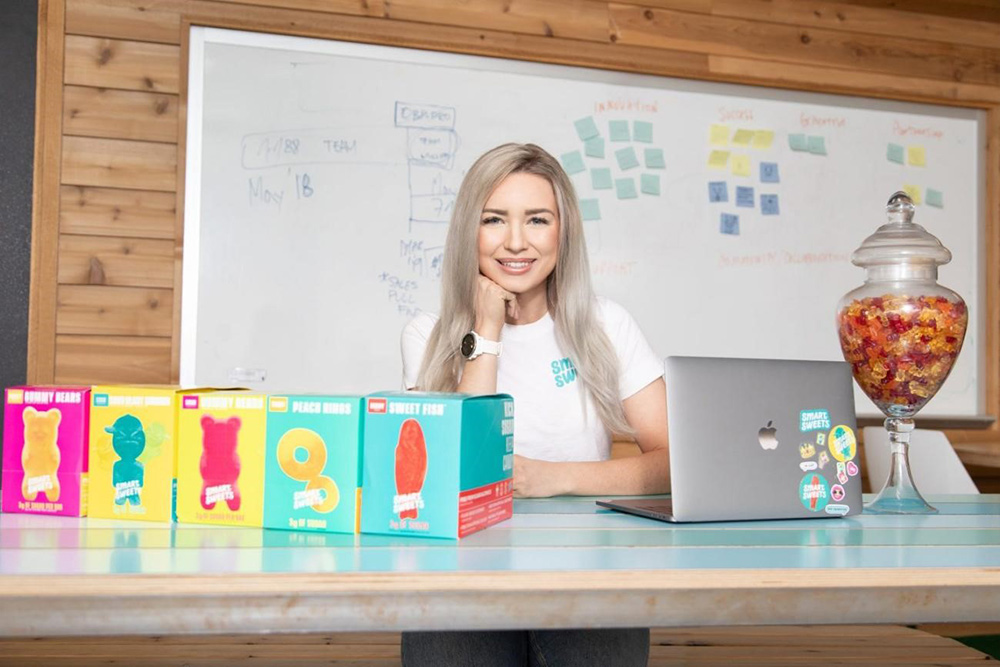
塔拉·博什深知,甜味可以给人带来快乐,但她相信,人们在不摄入过多糖分的情况下也能体验到这种快乐。
塔拉·博什今年29岁,她是加拿大人,从很小的时候她就要打两份工。她的妈妈是一位单身母亲,另外她还有一个溺爱她的祖母。她最美好的童年回忆就是和祖母一起分享糖果,祖母和她一样爱吃甜食。但是随着祖母年纪越来越大,祖母有些后悔自己吃了这么多甜食了,她曾经跟博什说,她很希望能有一种更好、更健康的选择来代替自己的甜食癖。
博什记住了祖母的心愿,并且积极付诸实践。她开始深入研究过度摄糖的问题,并且意识到,超市货架上的每种食品几乎都含有不少有害成分。但问题是,她自己也不想放弃吃糖的快乐。进入大学后没多久,她就在在地下室的小厨房里购置了几百个数百个小熊软糖模具,并且开始测试各种口味的糖果配方。
到了大二和大三的时候,她认为自己的实验已经有了一定成果,她不想过让自己后悔的人生,于是她就从大学退学了,开始全职制作低糖糖果。而事实证明她的选择是成功的。
但是,在她刚刚辞职创业时,她除了一辆2009年的本田飞度轿车,可以说一无所有。于是她借了105000美元作为启动资金,创办了SmartSweets品牌。它一经推出就获得了巨大的成功。创业第一年,她就卖出了200万美元的糖果,第二年达到1600万美元,第三年达到6000万美元,第四年直接破亿,达到1.25亿美元。2020年,SmartSweets被资产公司TPG Growth以3.6亿美元收购,创始人博什作为大股东一夜之间成为百万富翁。下面,她将向《财富》讲述她的成功之路。
为清晰起见,以下采访稿有删节。
说说你的出身背景?
我是加拿大不列颠哥伦比亚省的萨里长大的,那个地方位于加拿大的西海岸。我母亲是一位单亲妈妈,所以在目睹了她的经历,以及这些事对她的自尊和自信的影响后,我从小就有很强的动力去追求经济独立,走自己的路。
13岁的时候,我在麦当劳和多米诺比萨店打了两份工。当时我相当于是非法工作了一年,因为加拿大的最低劳动年龄是14岁。当时我既要打两份工,又要去上学。那时我拿的是最低工资,大约是每小时13加元。
我之所以要一边上学,一边打两份工,主要是因为目睹了我妈妈的经历——作为一个单亲妈妈,她失去了经济保障,一切都要重头开始,所以这让我有了很强的动力。
同时我也意识到,如果她不在我身边的话,我的生活会是什么样子,所以我很早就有了经济独立的想法。我知道了要考上大学的话,我最低得考多少分,然后在确保能考上大学的基础上,我把其他全部精力都放在了打工和挣钱上,因为我觉得这比拿到全A更有价值。
而且从那时起,我开始很认真地收看《鲨鱼坦克》和《龙穴》这种创业类的电视节目。我还会很认真地写下很多想法,但是由于我自己的饮食习惯都很不健康,所以我并没有信心付诸行动。
我小时很喜欢吃糖,可以说一吃就停不下来,但是吃完糖后我又有一种罪恶感。就这样,我陷入了一个很不健康的循环,有时糖吃多了,我就会限制自己吃糖。这也严重影响了我的自尊和自信。等到十几岁的时候,我开始在一家保健品商店里打工,我的老板成了我的第一位导师。
她教会了我一点,那就是面对你喜欢的食物,最重要的是找到更明智的选择。这番建议帮助我建立了与食物之间的健康关系。几年后,我的祖母(她也是我童年时最好的朋友)有一次对我说,她很后悔自己吃了那么多糖——尤其是各种糖果,而且在我小的时候,我们俩经常一起吃糖。
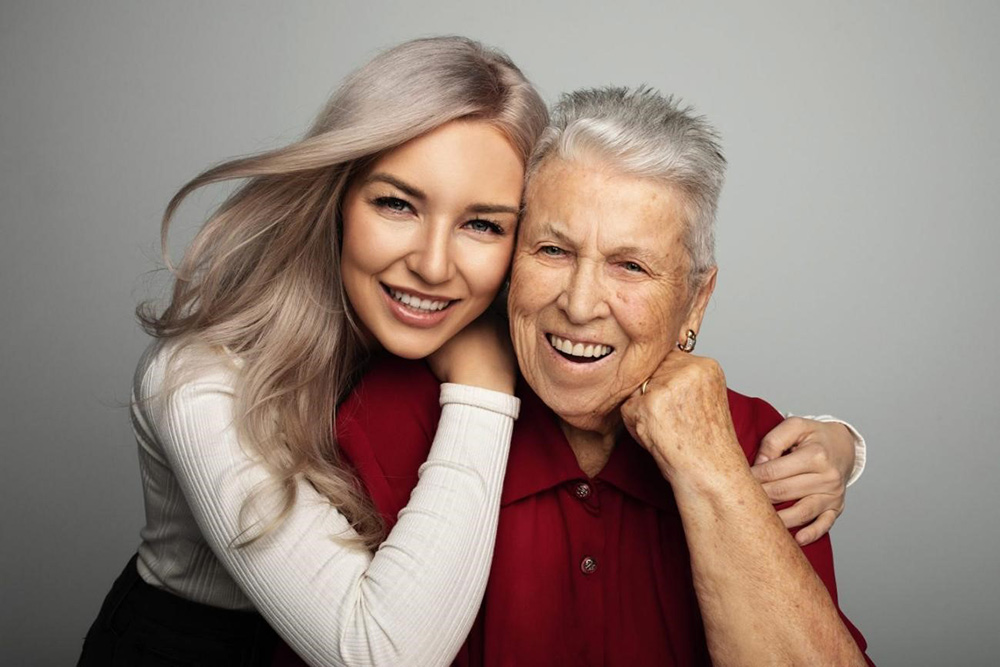
当时我就想,哇,你竟然会因为自己吃多了什么东西而内疚一辈子。那一刻,我不禁在心里问自己,为什么你就不能享受吃糖的甜蜜呢?
你在哪儿上的大学?
在加拿大的不列颠哥伦比亚大学。考上大学后,我还跟我的高中老师有过一次谈话,我记得他当时对我说:“我知道你考上大学了,但是上大学并不适合每个人。”他建议我走一条不同的路,而不是走上大学这条路。
在我成长的过程中,我经常觉得同龄人都瞧不起我,这可能与我的自尊心和自信心不足有关。上了大学以后,我也不知道自己对什么感兴趣。我上的是艺术系,但是我在那里也没发现什么能让我感到兴奋的东西。所以我决定去学德语课,这样至少以后我还能用德语跟我的祖母对话。
不过在大学期间,我开始培养与食物之间更健康的关系,这反过来又让我对自己更有信心了。我第一次意识到,我有能力将一个想法付诸行动,并且将它变成现实。
我的第一个创业点子叫做“Decaled Out”,当时我只有17岁。这个点子主要针对学生和租房客。有的学生和租房者想装饰一下自己的墙壁,但是又不能用一些胶质材料和墙纸,以免给墙壁造成永久性损伤,我的那家公司主要就是解决这种需求的。那是我第一次接触生产、销售和分销这些业务。这家公司创办6个月就失败了。但是它也是一笔宝贵的财富,因为它让我学会了实现下一个想法所需的经验。
你是哪个学期从大学退学的?你是怎么做出这个决定的?
2015年夏天,也就是大二到大三的那个暑假,我依然没有找到自己热衷的事情。但是就在那时,我有了第一次创业失败后的第二个想法,也就是SmartSweets。我全身心地投入到了这个想法中。到那个夏天结束的时候,我很容易地就做出了退学的决定。
我当时想,如果我90岁了,回首自己的一生,我可不想说“如果我当初如何如何该有多好”这样的话。我不想给自己的人生留下任何“如果”。如果这个创意失败了,我大不了再回大学完成学业。但是如果我没有按照内心的感觉走,没有朝着这个想法去尝试,那我一定会后悔的。
而与祖母的那次谈话也对我很有启发。我想,世界上为什么没有这种又健康又让人快乐的东西呢?同时,我也意识到了过分摄糖对健康造成的危害,同时我也意识到,糖摄入过量已经成了一个全球性的问题,这是一场无声的流行病。而且我又想,如果我们能让糖果里不含糖(糖果货架也是超市里含糖量最高的货架),那我们就更有底气去问,为什么现在的包装食品里要添加这么多糖。
有了这个点子之后,我立刻开始学习关于糖摄入过量的知识。我从亚马逊上买了一个小熊软糖模具,带着从网上买来的所有原料,包括一个糖果温度计,钻进了地下室的厨房里。然后我一整个夏天都在测试各种糖果配方。
那个糖果模具有大约120个小熊软糖形状的空腔,所以我在那个夏天努力实现的第一个创新,就是低糖的小熊软糖。之所以选择小熊软糖,是因为我认为每个人在一生的某个阶段都会有爱上小熊软糖的记忆。我首先尝试的是水果味和酸味的小熊软糖,但是我同时也在测试棉花糖的配方。这不是为了迎合大众消费者,更多的是我自己喜欢棉花糖,想要搞出一个低糖版本。不过我最后还是放弃了棉花糖项目,只专注于小熊软糖。
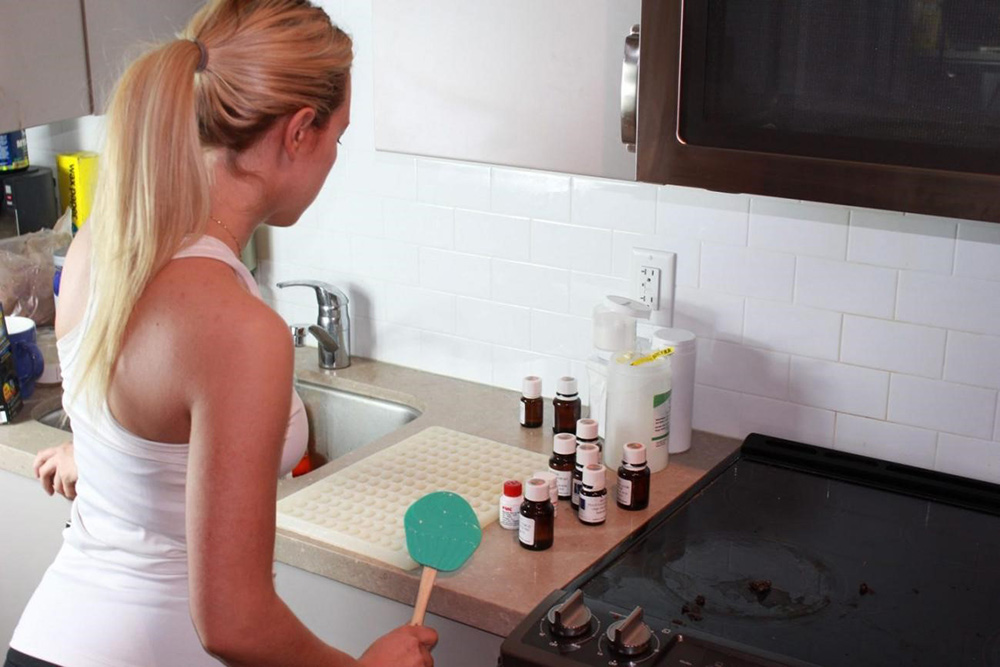
在你决定退学时,你的家人和朋友做何反应?
周围的人都觉得我疯了。我的祖母简直不敢相信这件事,因为她从小就在为我上大学攒钱。她觉得我怎么可能放弃上大学这么重要的事,跑到厨房里去做糖果呢?其实对我来说,她的态度才是最重要的。我所有的家人和朋友也都认为我走火入魔了。但在我人生的那个阶段,被低估和误解的感觉对我来说太正常了,所以我很容易地就无视了别人的看法。
直到SmartSweets上了加拿大版创业节目《龙穴》(Dragon's Den),我祖母才明白:“哦,原来创业是这么回事。”她成了我们最热情的推销员,向她楼里的所有人热情推销我们的产品。
你当时学了哪些关于制作糖果的教程吗?
对,我查阅了所有关于糖果制作的科学文献,还研究了他们用来做冰淇淋的一些创新原料。
在创办SmartSweets之前,我在糖果制作方面毫无经验,甚至连下厨都没什么经验。对我来说,一切都是全新的,只能从零开始,边学边做。
糖果的制作温度是很高的。所以我在地下室做试验时,有的时候会有很大的蒸汽,甚至飘到了楼上房东的家里。他们当时还以为我在做大麻软糖,或者是在干什么其他非法的东西。
一开始,我有几百上千次实验都失败了。有的一开始看起来还不错,但是过了五分钟就变形了,完全看不出小熊的样子,有的不到一天就变质了。经过几百上千次试验的不断积累,我做出来的小熊软糖终于让我觉得,哇,这个味道才真的带能给我吃糖时的快乐感。
你第一次做试验时是几岁?
我第一次带着模具在地下室做实验时是21岁。
你当时住在哪?
我当时住在温哥华。我在校外租了一间小地下室。在开始做试验后不到一年,我就开着我的本田飞度小轿车,送出了我的第一批货。
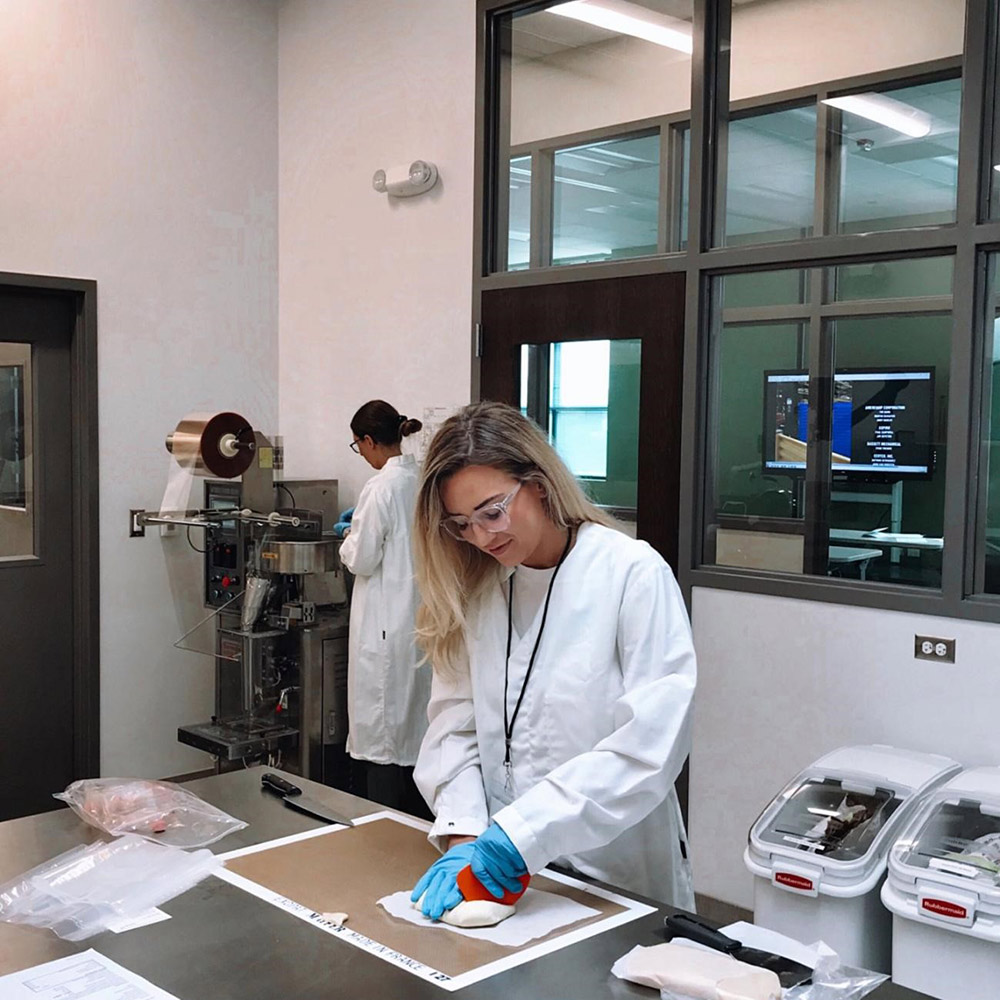
我从一开始就很想找一个全国性的销售伙伴。当时社交媒体刚刚兴起,我想的是,如果消费者能在社交媒体上看到我们,但是却没法在附近的商店买到我们的产品,这一定会让他们很不爽。Bed Bath & Beyond是第一家与我们合作的全国性大型零售商,而且就在我们的产品刚推出一个月,他们就与我们合作了。
与Bed Bath & Beyond 的合作归根,是我们发展低糖糖果产业的重要一步。我很坚定地对他们说,低糖糖果这个品类肯定会越做越大,如果你们现在就把宝押在我们身上,我保证你们会物有所值的。我向他们描绘了未来超市里的糖果货架会是什么样子,并且说这里一定有巨大的利益空间。
与货架上的其他糖果产品相比,我们的糖果销量更高,所以我们能为他们赚到更多钱,这对零售商来说非常重要。
在签下第一个全国性的零售渠道商之前,我们的第一批客户主要是温哥华及其周边地区的小型零售连锁店,比如Choices Markets、Nature's Fare等主打天然食品的小型连锁超市。
你是怎么给你的公司融资的?
在我创办SmartSweets的时候,除了一辆2009年的本田飞度小轿车,我可以说是一无所有。为了创办这家公司,我拿这辆本田飞度进行了105000美元的债务融资。我还购买了人寿保险作为贷款抵押。
你是怎么想到SmartSweets这个名字的?
它一开始的名称是Stevi Sweets,Stevi是指一种名叫甜菊糖的甜味剂。在投产之前,我们的生产伙伴提出,必须提高产量才肯生产——因为当时圣诞节快到了。于是就在圣诞节的前几天,我给几个投资人打了电话,想看看他们是否有兴趣。其中有些人回复了我,但是没人有兴趣尝试这款产品,因为他们不喜欢甜菊糖的后味。这个问题在这时暴露出来是很幸运的,于是我立即将公司的名字改成了SmartSweets。
SmartSweets是一个好名字,而且也暗示了选择它比传统糖果更明智。
你的产品当时的包装是什么样子的?
我们的产品第一次在货架上展出时,我站在糖果货架前面盯着它看了几个小时。然后我很快意识到,它看起来就像一只独角兽吐了一地的样子。我们最初的包装是非常简约的白色,为的就是在五颜六色的糖果包装中显得不一样。
一开始,你是如何让人们了解你的产品的?
我从大学辍学后,非常幸运地被吸收进了一个叫做“The Next Big Thing”的创业加速器项目。那里都是非常有才华的年轻人,在从事科技和美容等领域的创业。我是其中唯一一个做食品的,所以很快我就学到了一些东西,比如要去围绕产品去构建社群,而不仅仅是围绕产品打造品牌。我把这些知识都应用到了SmartSweets 上。
从创业的第一天起,我就非常重视围绕SmartSweets打造社群,所以我非常重视社交媒体。我曾看过蒂姆·费里斯的一篇文章,内容是说他是怎样将他的作品《每周工作四小时》推广成一本畅销书的。他在文中谈到,他当时也没有钱向人们推广这本书,所以他首先考虑的是这本书对哪些人群最有价值,并率先盯准这个细分市场进行推广,然后再扩大规模。
我在SmartSweets上也采用了相同的策略。一开始,我们利用社交网络瞄准了减肥群体。不到3个月,SmartSweets这个品牌就在减肥人群中火了起来。但实际上,我们仍然是一家非常小的公司,只是精准定位了这个细分市场。
通过这些细分市场,我们很快构建了一个由热衷戒糖人士组成的社群,他们成了我们的种子用户,让我们很快开出了花。是这些朋友的热情,让我们利用社交媒体成功打造了这个社群。
你是什么时候意识到,你的业务已经起飞了,你的公司将要成功了?
从第一天开始,在我还在厨房里做试验的时候,我就很努力地将Smart Sweet的宏大愿景植入我的潜意识中。这个宏大愿景就是要让Smart Sweet成为一个全球性的领导者,在糖果行业掀起一场革命。然后我再一步步地反向思考,一直回到第一步,也就是现在的小厨房。然后我想,现在我需要怎么做,才能一步步迈向全球领导者这个最终愿景呢?这时它对我来说已经是一个十分真实的目标了。
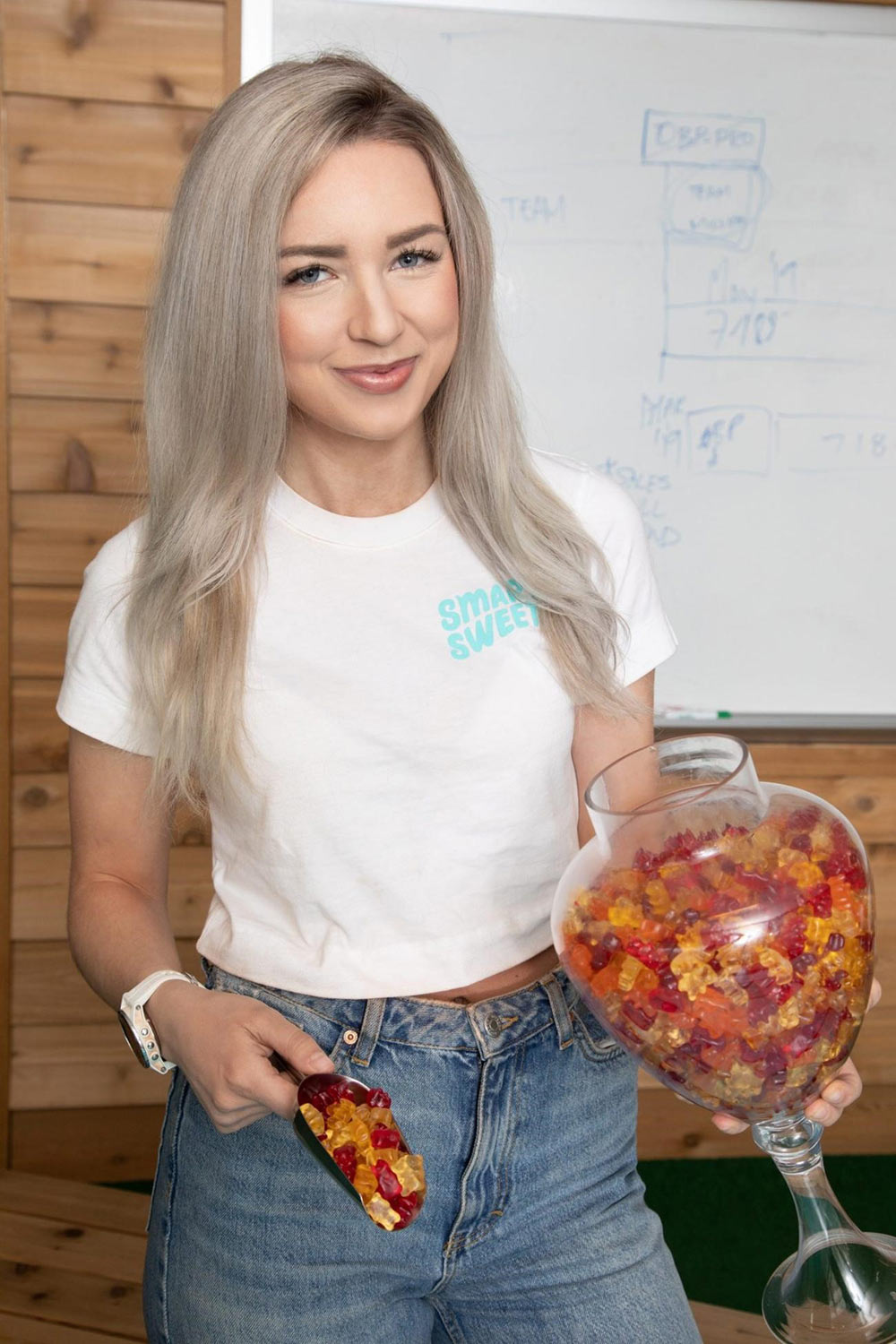
你是什么时候拿到第一张大额支票的?
在创办SmartSweets的过程中,我一直过得非常拮据。在创业的头两年,我没有拿工资。后来,我们入选了彼得·蒂尔奖学金项目,该项目为我的公司提供了10万美元的无条件资助,我这才开始给自己发工资。我把这笔钱分成两年,也就是每年拿5万美元的工资。我之所以一直过着拮据的生活,是想保证公司的现金流。直到SmartSweets 的多数股份被收购以后,我才第一次领到了一大笔薪水——那是一笔不小的数字。SmartSweets多数股份以3.6亿美元的价格被收购,而在此之前我就是多数股份的所有者。
至于销售额,第一年我们卖了200万美元,第二年卖了1600万美元,第三年卖了6000万美元,第四年我们卖了1.25 亿美元。
你为什么要申请彼得·蒂尔奖学金?
这个奖学金是专门面向那些23岁以下有志于辍学创业的大学生的,它会一次性资助10万美元,用于帮助他们实现自己的创意。它每年收到的申请非常多,基本上都会超过1万份。我申请的时候,就觉得自己“德不配位”,绝对不可能被录取。但我总是抱着一种“不试试怎么知道”的态度。所以我就申请了。
于是我提交了在线申请,并且通过了第一轮面试。后来他们让我们飞到旧金山进行下一轮面试。我就想,我肯定是不行的,因为这些人都很厉害。但我还是进入了下一轮面试。不过我的自我否定越来越严重了。我想的是,这下我总该被淘汰了吧?但能认识这些了不起的人也很不错。结果我就被选中了。
你给自己买过的最贵的东西是什么?
那肯定是我的第一套房子了,直到现在我都觉得很不现实。那是在疫情期间,也就是我们刚被收购以后,我想从城市里搬出去,搬到森林里生活。于是我发现了一个很好的地方,那是一个叫惠斯勒的城市,它是一个滑雪小镇,离温哥华往北有两小时车程。我在那里买了一套房子。第一个月,我走在房子里,还经常感觉这是别人的房子,因为这种感觉好得简直不真实。在我成长的过程中,我甚至从没想过世界上还有这样的房子。
你学到的最重要的一课是什么?
我的孩子现在还在蹒跚学步呢,但是我每天都会跟她分享这句咒语:“你的能力是无限的,你是受到上天眷顾的,你能创造力也是无限的。”从我的人生旅途中,我真正意识到了,没有什么事是做不到的。当你刚起步时,你觉得5家店就很大了,当你有了5家店,你又觉得10家店很大,然后是1000家、10000家、100000家。当你越过这些门槛时,它们就不再显得遥不可及,也不再是什么无法实现的事情。你会慢慢开始意识到,这个世界真的什么事情都有可能发生,而唯一的限制,其实在于你的头脑中,在于你对自己的限制。
我学到的另一个经验是,当年我还在地下室的厨房里研制糖果配方时,有时我从睡梦中醒来,经常会有几乎令人麻痹的恐惧感、不适感、不安全感和自我怀疑。我总以为这种感觉会在某个时候消失。一开始,我会读一些俗气的名人名言,听一些俗气的励志歌曲,从书里撕几句打鸡血的话贴在门上。有时我还会在镜子和冰箱上贴上“你能行”之类的话,给自己加油打气。
随着公司的发展壮大,这种感觉也从未消失,但我必须每天要不断地让自己相信自己的能力。无论是开着我的本田飞度给第一批渠道商送货的时候,还是与我的80名团队成员开视频会议的时候,我都有一种“德不配位”的感觉。
所以说,我从第一天起就知道,每个人在人生旅途中都会有这种感觉,尤其是女性。如果再来一次,我可能不会那么缺乏安全感了,也不会放大自我怀疑了。
你是什么时候开始招聘员工的?
当年我在厨房里试验配方的时候,全靠我一个人。过了不到一年,到我们开始供货的时候,我招聘了我们的第一位员工,她第一年的薪水是3万美元,她是个很有风度而且很了不起的人,而且她真正认可我们的愿景。她也愿意拿更多的股权,因为我们第一年基本上过着白手起家的生活。到了第四年,我们有了80多名员工,年收入也达到了1.25亿美元。
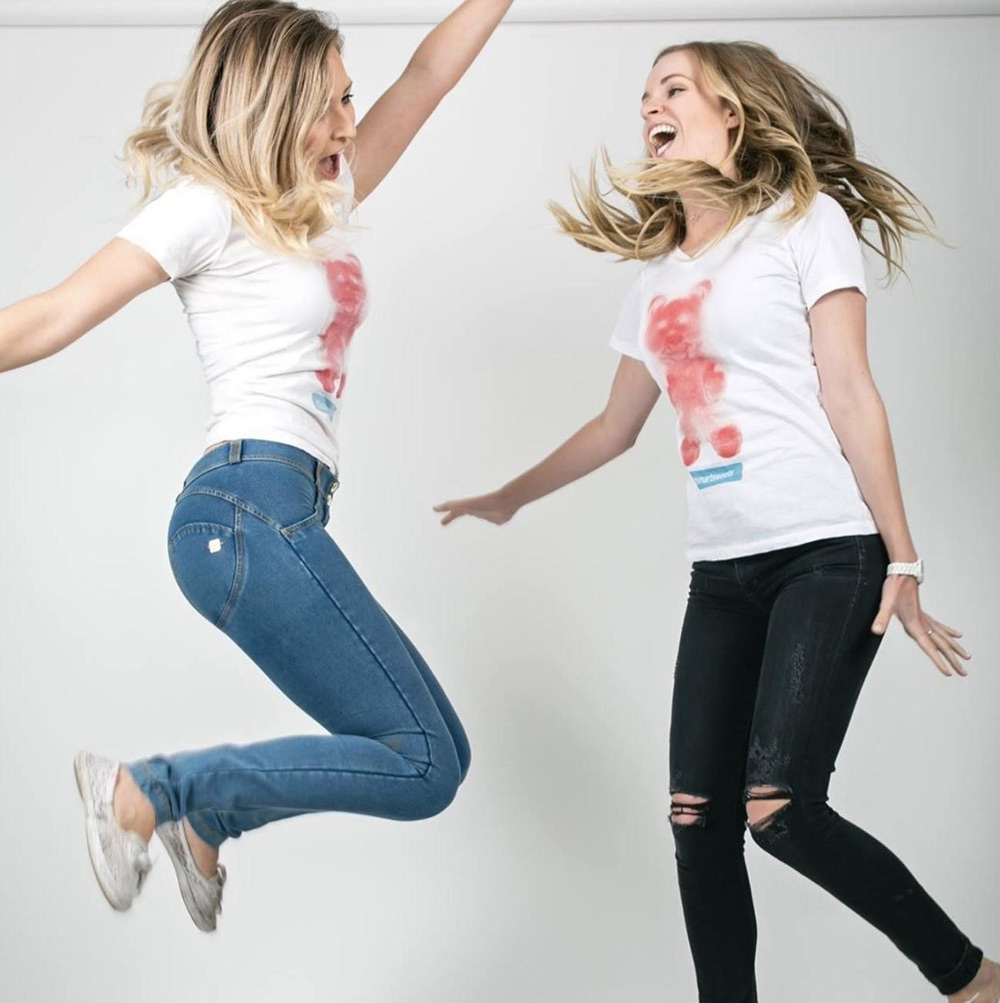
你为什么决定卖掉公司?
我一直都知道,一旦SmartSweets发展到了某个阶段,它就应该与一个更大的全球性企业合作,以拓宽我们的生产和销售渠道,从而实现我们全球糖果行业变革领导者的宏大愿景。
与此同时,当我们的年收入接近1亿美元大关时,我真的觉得自己没有了那种洞察力,也在想我自己是不是最好的CEO人选。对于我自己,我从一开始想的就是,我怎样才能最好地完成这个目标?怎样才能把公司支撑起来?
在一开始的时候,我会亲自扫地、装箱。到了第四年,我才真正意识到,如果我失去了对未来的洞察力,我就会阻碍公司下一步的发展。所以不管怎样,我得聘请一位CEO。现在我只是觉得做这两件事的时机恰好到了。如今我仍然是公司最大的个人股东,也是董事会成员。
公司现在在哪里?
目前,SmartSweets已成为北美销量第一的低糖糖果。我们已经进入了加拿大和美国的130000家零售门店。迄今为止,我们已经帮助人们减少了超过56亿克的糖分摄入。
你能说说你卖掉公司之前的收入吗?
到了第四年,我们的年收入已经达到了1.25亿美元。公司多数股被收购后,我赚到了第一笔巨款,那时我25岁。
你记得当时大家的心情吗?
SmartSweets的核心理念之一是,我一直尊重所有陪我一路走来的人。我们团队的每个人都有股权。我对他们说,我对他们的希望是,SmartSweets可以成为他们人生旅途中的一个坚实的依靠,无论是买一辆他们梦想中的汽车,还是为他们梦想的房子交首付。
公司被收购之后,我看见大家都迎来了梦想变现的时刻,这对我来说是最激动人心的事情。而我最激动的时刻,就是我终于可以照顾我的祖母和妈妈了。这是一个圆满的时刻,也是最好的礼物。
你现在的资产净值大概是多少?
2亿美元。
为什么你觉得有必要去帮助其他女性领导者?
在我刚开始创业的时候,我读了很多书,也看了很多播客和YouTube上的视频,而且我有幸从很多优秀的人身上学到了东西。不过这些故事大多数是男性的成功经历,所以我有时不能完全代入他们。所以,我现在觉得有必要分享我自己的创业之路,希望能够启发她们,给她们将理想付诸行动的自信,让她们知道自己也有无限的能力。
你现在有徒弟吗?或者你是否在跟某个机构合作来做这件事?
我非常热衷于为其他年轻女性创业提供支持,我想让她们知道,有的时候感到“德不配位”、“本领恐慌”是很正常的。我希望能在她们实践自己的创意的过程中,为她们提供必要的知识和情绪支持。
因此,我创办了一个名叫“大胆开始”的项目。每年我们都会在北美地区征集一批优秀女性,为她们提供一笔2.5万美元的无担保创业补助金。这是一个很好的项目,但最重要的是,她们的点子是这个世界所需要的,而上天恰恰把这点子赋予了这些人,而且她们的创造力是无限的。
你认为你成功的秘诀是什么?
我认为这没有什么秘诀。即便是最终获得成功的人,他们跟每个普通人一样,也会有恐惧感、不安全感,也会陷入自我怀疑。尽管如此,他们依然有能力每天前进一步。
所以说,我们要有牛一样的心态,要敢于冲开障碍,相信一切皆有可能。如果有人不回复你的邮件,并不是因为他们不喜欢你,只是意味着你要另辟蹊径来打开这扇门。你要坚持不懈地追求你要创造的东西,而且你要明白你做这件事的意义是什么,这个意义必须要大于你个人的追求。
创业的旅途也是很艰辛的,如果你不努力在世界上制造积极的影响,而且如果你的创业目标没有远远高于你个人的追求,这个过程就会变得很沉重。
博
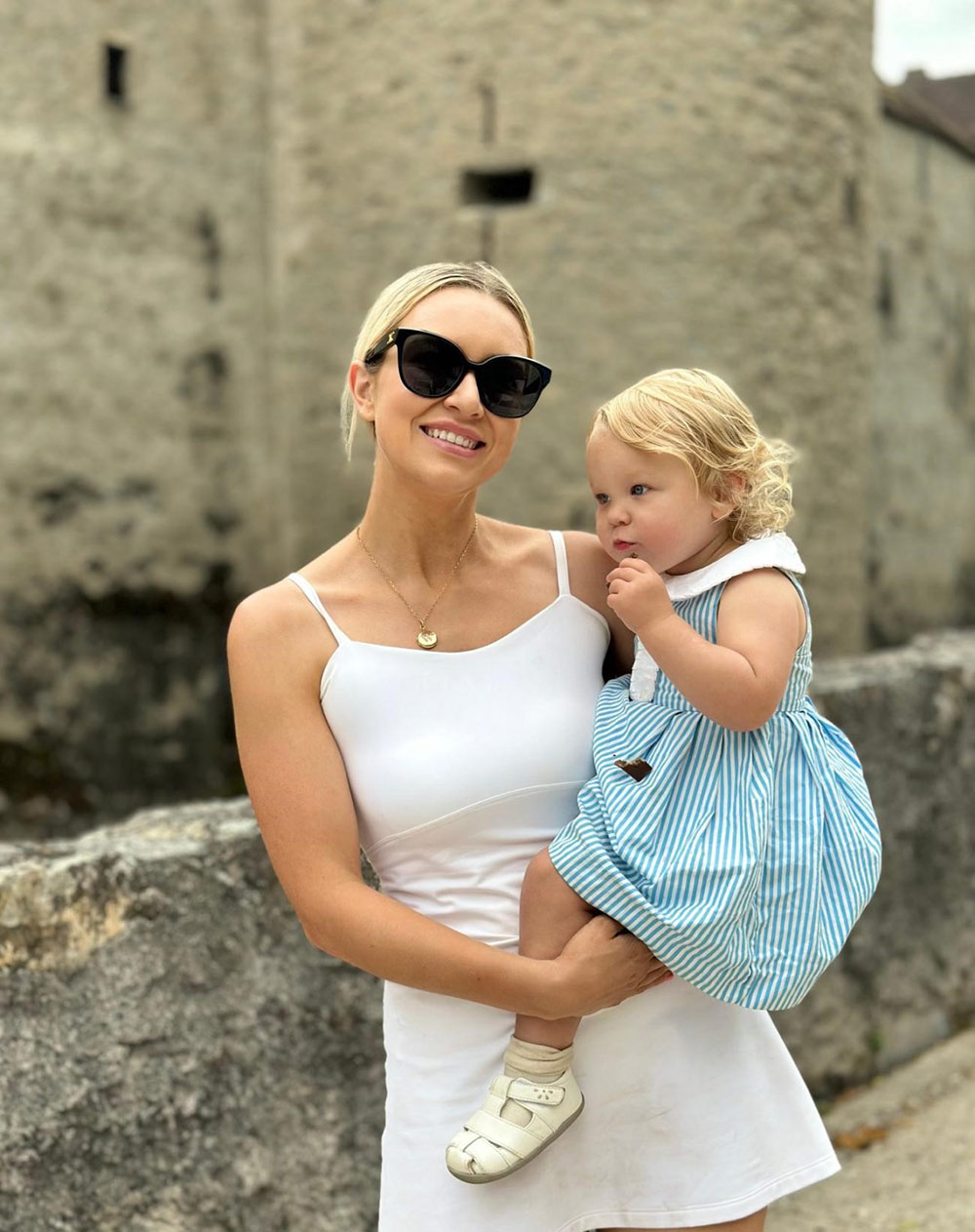
你遇见过仇恨你的人吗?
在我看来,那些仇视我的人,可能只是在我的人生旅途上低估过我的人。我会在手机里存一个小名单,记下那些低估过我的人的名字。我会把这种情绪带到工作中,而且这给了我不少动力。
举个例子吧,很早以前,我曾经受邀参加过一个创业加速器项目,邀请我的是一位我非常钦佩的成功人士。但是显然这位成功人士并不认为我的公司会获得成功,所以他们并没有花多少时间和精力来和我打招呼,甚至也没有尝试一下我的产品。人们常说,“永远不要去见你的偶像”,这句话说得太对了,当时我简直要崩溃了。但是随着时间的推移,几年后,那个人又联系了我,并且说,我一直关注着你的创业之路,祝贺你。
在支持其他女性和下一代女性创业者的过程中,有一件小事也很具有代表性,我很想其他女性“端走整个盘子”。
有一次,我和一个在创业加速器项目中认识的朋友一起参加一个发布会。活动快结束的时候,桌子上还剩下一盘三明治。当时我们正处于初创期,午饭只能吃两块钱的松饼。我们就说,如果有这些三明治吃就太好了。
当时,我们站在那里讨论着是否应该打包一点三明治带回家,又觉得这样是不是很不礼貌,会让别人对我们评头论足的。就在我们站在那里犹豫不决的时候,有个男的走了过去,拿走了整盘三明治。
那一刻,我俩面面相觑,然后我们发誓以后一定要整盘端走。我也想鼓励其他女性,要想在这个世界上占据一席之地,就要敢于以自己的方式端走整个盘子。(财富中文网)
译者:朴成奎
SmartSweets创始人塔拉·博什。SmartSweets是北美地区最受欢迎的低糖糖果。
塔拉·博什深知,甜味可以给人带来快乐,但她相信,人们在不摄入过多糖分的情况下也能体验到这种快乐。
塔拉·博什今年29岁,她是加拿大人,从很小的时候她就要打两份工。她的妈妈是一位单身母亲,另外她还有一个溺爱她的祖母。她最美好的童年回忆就是和祖母一起分享糖果,祖母和她一样爱吃甜食。但是随着祖母年纪越来越大,祖母有些后悔自己吃了这么多甜食了,她曾经跟博什说,她很希望能有一种更好、更健康的选择来代替自己的甜食癖。
博什记住了祖母的心愿,并且积极付诸实践。她开始深入研究过度摄糖的问题,并且意识到,超市货架上的每种食品几乎都含有不少有害成分。但问题是,她自己也不想放弃吃糖的快乐。进入大学后没多久,她就在在地下室的小厨房里购置了几百个数百个小熊软糖模具,并且开始测试各种口味的糖果配方。
到了大二和大三的时候,她认为自己的实验已经有了一定成果,她不想过让自己后悔的人生,于是她就从大学退学了,开始全职制作低糖糖果。而事实证明她的选择是成功的。
但是,在她刚刚辞职创业时,她除了一辆2009年的本田飞度轿车,可以说一无所有。于是她借了105000美元作为启动资金,创办了SmartSweets品牌。它一经推出就获得了巨大的成功。创业第一年,她就卖出了200万美元的糖果,第二年达到1600万美元,第三年达到6000万美元,第四年直接破亿,达到1.25亿美元。2020年,SmartSweets被资产公司TPG Growth以3.6亿美元收购,创始人博什作为大股东一夜之间成为百万富翁。下面,她将向《财富》讲述她的成功之路。
为清晰起见,以下采访稿有删节。
说说你的出身背景?
我是加拿大不列颠哥伦比亚省的萨里长大的,那个地方位于加拿大的西海岸。我母亲是一位单亲妈妈,所以在目睹了她的经历,以及这些事对她的自尊和自信的影响后,我从小就有很强的动力去追求经济独立,走自己的路。
13岁的时候,我在麦当劳和多米诺比萨店打了两份工。当时我相当于是非法工作了一年,因为加拿大的最低劳动年龄是14岁。当时我既要打两份工,又要去上学。那时我拿的是最低工资,大约是每小时13加元。
我之所以要一边上学,一边打两份工,主要是因为目睹了我妈妈的经历——作为一个单亲妈妈,她失去了经济保障,一切都要重头开始,所以这让我有了很强的动力。
同时我也意识到,如果她不在我身边的话,我的生活会是什么样子,所以我很早就有了经济独立的想法。我知道了要考上大学的话,我最低得考多少分,然后在确保能考上大学的基础上,我把其他全部精力都放在了打工和挣钱上,因为我觉得这比拿到全A更有价值。
而且从那时起,我开始很认真地收看《鲨鱼坦克》和《龙穴》这种创业类的电视节目。我还会很认真地写下很多想法,但是由于我自己的饮食习惯都很不健康,所以我并没有信心付诸行动。
我小时很喜欢吃糖,可以说一吃就停不下来,但是吃完糖后我又有一种罪恶感。就这样,我陷入了一个很不健康的循环,有时糖吃多了,我就会限制自己吃糖。这也严重影响了我的自尊和自信。等到十几岁的时候,我开始在一家保健品商店里打工,我的老板成了我的第一位导师。
她教会了我一点,那就是面对你喜欢的食物,最重要的是找到更明智的选择。这番建议帮助我建立了与食物之间的健康关系。几年后,我的祖母(她也是我童年时最好的朋友)有一次对我说,她很后悔自己吃了那么多糖——尤其是各种糖果,而且在我小的时候,我们俩经常一起吃糖。
当时我就想,哇,你竟然会因为自己吃多了什么东西而内疚一辈子。那一刻,我不禁在心里问自己,为什么你就不能享受吃糖的甜蜜呢?
你在哪儿上的大学?
在加拿大的不列颠哥伦比亚大学。考上大学后,我还跟我的高中老师有过一次谈话,我记得他当时对我说:“我知道你考上大学了,但是上大学并不适合每个人。”他建议我走一条不同的路,而不是走上大学这条路。
在我成长的过程中,我经常觉得同龄人都瞧不起我,这可能与我的自尊心和自信心不足有关。上了大学以后,我也不知道自己对什么感兴趣。我上的是艺术系,但是我在那里也没发现什么能让我感到兴奋的东西。所以我决定去学德语课,这样至少以后我还能用德语跟我的祖母对话。
不过在大学期间,我开始培养与食物之间更健康的关系,这反过来又让我对自己更有信心了。我第一次意识到,我有能力将一个想法付诸行动,并且将它变成现实。
我的第一个创业点子叫做“Decaled Out”,当时我只有17岁。这个点子主要针对学生和租房客。有的学生和租房者想装饰一下自己的墙壁,但是又不能用一些胶质材料和墙纸,以免给墙壁造成永久性损伤,我的那家公司主要就是解决这种需求的。那是我第一次接触生产、销售和分销这些业务。这家公司创办6个月就失败了。但是它也是一笔宝贵的财富,因为它让我学会了实现下一个想法所需的经验。
你是哪个学期从大学退学的?你是怎么做出这个决定的?
2015年夏天,也就是大二到大三的那个暑假,我依然没有找到自己热衷的事情。但是就在那时,我有了第一次创业失败后的第二个想法,也就是SmartSweets。我全身心地投入到了这个想法中。到那个夏天结束的时候,我很容易地就做出了退学的决定。
我当时想,如果我90岁了,回首自己的一生,我可不想说“如果我当初如何如何该有多好”这样的话。我不想给自己的人生留下任何“如果”。如果这个创意失败了,我大不了再回大学完成学业。但是如果我没有按照内心的感觉走,没有朝着这个想法去尝试,那我一定会后悔的。
而与祖母的那次谈话也对我很有启发。我想,世界上为什么没有这种又健康又让人快乐的东西呢?同时,我也意识到了过分摄糖对健康造成的危害,同时我也意识到,糖摄入过量已经成了一个全球性的问题,这是一场无声的流行病。而且我又想,如果我们能让糖果里不含糖(糖果货架也是超市里含糖量最高的货架),那我们就更有底气去问,为什么现在的包装食品里要添加这么多糖。
有了这个点子之后,我立刻开始学习关于糖摄入过量的知识。我从亚马逊上买了一个小熊软糖模具,带着从网上买来的所有原料,包括一个糖果温度计,钻进了地下室的厨房里。然后我一整个夏天都在测试各种糖果配方。
那个糖果模具有大约120个小熊软糖形状的空腔,所以我在那个夏天努力实现的第一个创新,就是低糖的小熊软糖。之所以选择小熊软糖,是因为我认为每个人在一生的某个阶段都会有爱上小熊软糖的记忆。我首先尝试的是水果味和酸味的小熊软糖,但是我同时也在测试棉花糖的配方。这不是为了迎合大众消费者,更多的是我自己喜欢棉花糖,想要搞出一个低糖版本。不过我最后还是放弃了棉花糖项目,只专注于小熊软糖。
2015年,博什在地下室的厨房里做试验。
在你决定退学时,你的家人和朋友做何反应?
周围的人都觉得我疯了。我的祖母简直不敢相信这件事,因为她从小就在为我上大学攒钱。她觉得我怎么可能放弃上大学这么重要的事,跑到厨房里去做糖果呢?其实对我来说,她的态度才是最重要的。我所有的家人和朋友也都认为我走火入魔了。但在我人生的那个阶段,被低估和误解的感觉对我来说太正常了,所以我很容易地就无视了别人的看法。
直到SmartSweets上了加拿大版创业节目《龙穴》(Dragon's Den),我祖母才明白:“哦,原来创业是这么回事。”她成了我们最热情的推销员,向她楼里的所有人热情推销我们的产品。
你当时学了哪些关于制作糖果的教程吗?
对,我查阅了所有关于糖果制作的科学文献,还研究了他们用来做冰淇淋的一些创新原料。
在创办SmartSweets之前,我在糖果制作方面毫无经验,甚至连下厨都没什么经验。对我来说,一切都是全新的,只能从零开始,边学边做。
糖果的制作温度是很高的。所以我在地下室做试验时,有的时候会有很大的蒸汽,甚至飘到了楼上房东的家里。他们当时还以为我在做大麻软糖,或者是在干什么其他非法的东西。
一开始,我有几百上千次实验都失败了。有的一开始看起来还不错,但是过了五分钟就变形了,完全看不出小熊的样子,有的不到一天就变质了。经过几百上千次试验的不断积累,我做出来的小熊软糖终于让我觉得,哇,这个味道才真的带能给我吃糖时的快乐感。
你第一次做试验时是几岁?
我第一次带着模具在地下室做实验时是21岁。
你当时住在哪?
我当时住在温哥华。我在校外租了一间小地下室。在开始做试验后不到一年,我就开着我的本田飞度小轿车,送出了我的第一批货。
博什在进行糖果制作试验。
我从一开始就很想找一个全国性的销售伙伴。当时社交媒体刚刚兴起,我想的是,如果消费者能在社交媒体上看到我们,但是却没法在附近的商店买到我们的产品,这一定会让他们很不爽。Bed Bath & Beyond是第一家与我们合作的全国性大型零售商,而且就在我们的产品刚推出一个月,他们就与我们合作了。
与Bed Bath & Beyond 的合作归根,是我们发展低糖糖果产业的重要一步。我很坚定地对他们说,低糖糖果这个品类肯定会越做越大,如果你们现在就把宝押在我们身上,我保证你们会物有所值的。我向他们描绘了未来超市里的糖果货架会是什么样子,并且说这里一定有巨大的利益空间。
与货架上的其他糖果产品相比,我们的糖果销量更高,所以我们能为他们赚到更多钱,这对零售商来说非常重要。
在签下第一个全国性的零售渠道商之前,我们的第一批客户主要是温哥华及其周边地区的小型零售连锁店,比如Choices Markets、Nature's Fare等主打天然食品的小型连锁超市。
你是怎么给你的公司融资的?
在我创办SmartSweets的时候,除了一辆2009年的本田飞度小轿车,我可以说是一无所有。为了创办这家公司,我拿这辆本田飞度进行了105000美元的债务融资。我还购买了人寿保险作为贷款抵押。
你是怎么想到SmartSweets这个名字的?
它一开始的名称是Stevi Sweets,Stevi是指一种名叫甜菊糖的甜味剂。在投产之前,我们的生产伙伴提出,必须提高产量才肯生产——因为当时圣诞节快到了。于是就在圣诞节的前几天,我给几个投资人打了电话,想看看他们是否有兴趣。其中有些人回复了我,但是没人有兴趣尝试这款产品,因为他们不喜欢甜菊糖的后味。这个问题在这时暴露出来是很幸运的,于是我立即将公司的名字改成了SmartSweets。
SmartSweets是一个好名字,而且也暗示了选择它比传统糖果更明智。
你的产品当时的包装是什么样子的?
我们的产品第一次在货架上展出时,我站在糖果货架前面盯着它看了几个小时。然后我很快意识到,它看起来就像一只独角兽吐了一地的样子。我们最初的包装是非常简约的白色,为的就是在五颜六色的糖果包装中显得不一样。
一开始,你是如何让人们了解你的产品的?
我从大学辍学后,非常幸运地被吸收进了一个叫做“The Next Big Thing”的创业加速器项目。那里都是非常有才华的年轻人,在从事科技和美容等领域的创业。我是其中唯一一个做食品的,所以很快我就学到了一些东西,比如要去围绕产品去构建社群,而不仅仅是围绕产品打造品牌。我把这些知识都应用到了SmartSweets 上。
从创业的第一天起,我就非常重视围绕SmartSweets打造社群,所以我非常重视社交媒体。我曾看过蒂姆·费里斯的一篇文章,内容是说他是怎样将他的作品《每周工作四小时》推广成一本畅销书的。他在文中谈到,他当时也没有钱向人们推广这本书,所以他首先考虑的是这本书对哪些人群最有价值,并率先盯准这个细分市场进行推广,然后再扩大规模。
我在SmartSweets上也采用了相同的策略。一开始,我们利用社交网络瞄准了减肥群体。不到3个月,SmartSweets这个品牌就在减肥人群中火了起来。但实际上,我们仍然是一家非常小的公司,只是精准定位了这个细分市场。
通过这些细分市场,我们很快构建了一个由热衷戒糖人士组成的社群,他们成了我们的种子用户,让我们很快开出了花。是这些朋友的热情,让我们利用社交媒体成功打造了这个社群。
你是什么时候意识到,你的业务已经起飞了,你的公司将要成功了?
从第一天开始,在我还在厨房里做试验的时候,我就很努力地将Smart Sweet的宏大愿景植入我的潜意识中。这个宏大愿景就是要让Smart Sweet成为一个全球性的领导者,在糖果行业掀起一场革命。然后我再一步步地反向思考,一直回到第一步,也就是现在的小厨房。然后我想,现在我需要怎么做,才能一步步迈向全球领导者这个最终愿景呢?这时它对我来说已经是一个十分真实的目标了。
博什与她的低糖糖果。
你是什么时候拿到第一张大额支票的?
在创办SmartSweets的过程中,我一直过得非常拮据。在创业的头两年,我没有拿工资。后来,我们入选了彼得·蒂尔奖学金项目,该项目为我的公司提供了10万美元的无条件资助,我这才开始给自己发工资。我把这笔钱分成两年,也就是每年拿5万美元的工资。我之所以一直过着拮据的生活,是想保证公司的现金流。直到SmartSweets 的多数股份被收购以后,我才第一次领到了一大笔薪水——那是一笔不小的数字。SmartSweets多数股份以3.6亿美元的价格被收购,而在此之前我就是多数股份的所有者。
至于销售额,第一年我们卖了200万美元,第二年卖了1600万美元,第三年卖了6000万美元,第四年我们卖了1.25 亿美元。
你为什么要申请彼得·蒂尔奖学金?
这个奖学金是专门面向那些23岁以下有志于辍学创业的大学生的,它会一次性资助10万美元,用于帮助他们实现自己的创意。它每年收到的申请非常多,基本上都会超过1万份。我申请的时候,就觉得自己“德不配位”,绝对不可能被录取。但我总是抱着一种“不试试怎么知道”的态度。所以我就申请了。
于是我提交了在线申请,并且通过了第一轮面试。后来他们让我们飞到旧金山进行下一轮面试。我就想,我肯定是不行的,因为这些人都很厉害。但我还是进入了下一轮面试。不过我的自我否定越来越严重了。我想的是,这下我总该被淘汰了吧?但能认识这些了不起的人也很不错。结果我就被选中了。
你给自己买过的最贵的东西是什么?
那肯定是我的第一套房子了,直到现在我都觉得很不现实。那是在疫情期间,也就是我们刚被收购以后,我想从城市里搬出去,搬到森林里生活。于是我发现了一个很好的地方,那是一个叫惠斯勒的城市,它是一个滑雪小镇,离温哥华往北有两小时车程。我在那里买了一套房子。第一个月,我走在房子里,还经常感觉这是别人的房子,因为这种感觉好得简直不真实。在我成长的过程中,我甚至从没想过世界上还有这样的房子。
你学到的最重要的一课是什么?
我的孩子现在还在蹒跚学步呢,但是我每天都会跟她分享这句咒语:“你的能力是无限的,你是受到上天眷顾的,你能创造力也是无限的。”从我的人生旅途中,我真正意识到了,没有什么事是做不到的。当你刚起步时,你觉得5家店就很大了,当你有了5家店,你又觉得10家店很大,然后是1000家、10000家、100000家。当你越过这些门槛时,它们就不再显得遥不可及,也不再是什么无法实现的事情。你会慢慢开始意识到,这个世界真的什么事情都有可能发生,而唯一的限制,其实在于你的头脑中,在于你对自己的限制。
我学到的另一个经验是,当年我还在地下室的厨房里研制糖果配方时,有时我从睡梦中醒来,经常会有几乎令人麻痹的恐惧感、不适感、不安全感和自我怀疑。我总以为这种感觉会在某个时候消失。一开始,我会读一些俗气的名人名言,听一些俗气的励志歌曲,从书里撕几句打鸡血的话贴在门上。有时我还会在镜子和冰箱上贴上“你能行”之类的话,给自己加油打气。
随着公司的发展壮大,这种感觉也从未消失,但我必须每天要不断地让自己相信自己的能力。无论是开着我的本田飞度给第一批渠道商送货的时候,还是与我的80名团队成员开视频会议的时候,我都有一种“德不配位”的感觉。
所以说,我从第一天起就知道,每个人在人生旅途中都会有这种感觉,尤其是女性。如果再来一次,我可能不会那么缺乏安全感了,也不会放大自我怀疑了。
你是什么时候开始招聘员工的?
当年我在厨房里试验配方的时候,全靠我一个人。过了不到一年,到我们开始供货的时候,我招聘了我们的第一位员工,她第一年的薪水是3万美元,她是个很有风度而且很了不起的人,而且她真正认可我们的愿景。她也愿意拿更多的股权,因为我们第一年基本上过着白手起家的生活。到了第四年,我们有了80多名员工,年收入也达到了1.25亿美元。
你为什么决定卖掉公司?
我一直都知道,一旦SmartSweets发展到了某个阶段,它就应该与一个更大的全球性企业合作,以拓宽我们的生产和销售渠道,从而实现我们全球糖果行业变革领导者的宏大愿景。
与此同时,当我们的年收入接近1亿美元大关时,我真的觉得自己没有了那种洞察力,也在想我自己是不是最好的CEO人选。对于我自己,我从一开始想的就是,我怎样才能最好地完成这个目标?怎样才能把公司支撑起来?
在一开始的时候,我会亲自扫地、装箱。到了第四年,我才真正意识到,如果我失去了对未来的洞察力,我就会阻碍公司下一步的发展。所以不管怎样,我得聘请一位CEO。现在我只是觉得做这两件事的时机恰好到了。如今我仍然是公司最大的个人股东,也是董事会成员。
公司现在在哪里?
目前,SmartSweets已成为北美销量第一的低糖糖果。我们已经进入了加拿大和美国的130000家零售门店。迄今为止,我们已经帮助人们减少了超过56亿克的糖分摄入。
你能说说你卖掉公司之前的收入吗?
到了第四年,我们的年收入已经达到了1.25亿美元。公司多数股被收购后,我赚到了第一笔巨款,那时我25岁。
你记得当时大家的心情吗?
SmartSweets的核心理念之一是,我一直尊重所有陪我一路走来的人。我们团队的每个人都有股权。我对他们说,我对他们的希望是,SmartSweets可以成为他们人生旅途中的一个坚实的依靠,无论是买一辆他们梦想中的汽车,还是为他们梦想的房子交首付。
公司被收购之后,我看见大家都迎来了梦想变现的时刻,这对我来说是最激动人心的事情。而我最激动的时刻,就是我终于可以照顾我的祖母和妈妈了。这是一个圆满的时刻,也是最好的礼物。
你现在的资产净值大概是多少。
2亿美元。
为什么你觉得有必要去帮助其他女性领导者?
在我刚开始创业的时候,我读了很多书,也看了很多播客和YouTube上的视频,而且我有幸从很多优秀的人身上学到了东西。不过这些故事大多数是男性的成功经历,所以我有时不能完全代入他们。所以,我现在觉得有必要分享我自己的创业之路,希望能够启发她们,给她们将理想付诸行动的自信,让她们知道自己也有无限的能力。
你现在有徒弟吗?或者你是否在跟某个机构合作来做这件事?
我非常热衷于为其他年轻女性创业提供支持,我想让她们知道,有的时候感到“德不配位”、“本领恐慌”是很正常的。我希望能在她们实践自己的创意的过程中,为她们提供必要的知识和情绪支持。
因此,我创办了一个名叫“大胆开始”的项目。每年我们都会在北美地区征集一批优秀女性,为她们提供一笔2.5万美元的无担保创业补助金。这是一个很好的项目,但最重要的是,她们的点子是这个世界所需要的,而上天恰恰把这点子赋予了这些人,而且她们的创造力是无限的。
你认为你成功的秘诀是什么?
我认为这没有什么秘诀。即便是最终获得成功的人,他们跟每个普通人一样,也会有恐惧感、不安全感,也会陷入自我怀疑。尽管如此,他们依然有能力每天前进一步。
所以说,我们要有牛一样的心态,要敢于冲开障碍,相信一切皆有可能。如果有人不回复你的邮件,并不是因为他们不喜欢你,只是意味着你要另辟蹊径来打开这扇门。你要坚持不懈地追求你要创造的东西,而且你要明白你做这件事的意义是什么,这个意义必须要大于你个人的追求。
创业的旅途也是很艰辛的,如果你不努力在世界上制造积极的影响,而且如果你的创业目标没有远远高于你个人的追求,这个过程就会变得很沉重。
博什与她的女儿薇拉。
你遇见过仇恨你的人吗?
在我看来,那些仇视我的人,可能只是在我的人生旅途上低估过我的人。我会在手机里存一个小名单,记下那些低估过我的人的名字。我会把这种情绪带到工作中,而且这给了我不少动力。
举个例子吧,很早以前,我曾经受邀参加过一个创业加速器项目,邀请我的是一位我非常钦佩的成功人士。但是显然这位成功人士并不认为我的公司会获得成功,所以他们并没有花多少时间和精力来和我打招呼,甚至也没有尝试一下我的产品。人们常说,“永远不要去见你的偶像”,这句话说得太对了,当时我简直要崩溃了。但是随着时间的推移,几年后,那个人又联系了我,并且说,我一直关注着你的创业之路,祝贺你。
在支持其他女性和下一代女性创业者的过程中,有一件小事也很具有代表性,我很想其他女性“端走整个盘子”。
有一次,我和一个在创业加速器项目中认识的朋友一起参加一个发布会。活动快结束的时候,桌子上还剩下一盘三明治。当时我们正处于初创期,午饭只能吃两块钱的松饼。我们就说,如果有这些三明治吃就太好了。
当时,我们站在那里讨论着是否应该打包一点三明治带回家,又觉得这样是不是很不礼貌,会让别人对我们评头论足的。就在我们站在那里犹豫不决的时候,有个男的走了过去,拿走了整盘三明治。
那一刻,我俩面面相觑,然后我们发誓以后一定要整盘端走。我也想鼓励其他女性,要想在这个世界上占据一席之地,就要敢于以自己的方式端走整个盘子。(财富中文网)
译者:朴成奎
Bosch and her creation: SmartSweets, the most popular low-sugar candy brand in North America.
COURTESY OF SMARTSWEETS
Tara Bosch knows how much joy candy brings. She just doesn’t think that joy needs to be so sugary.
The 29-year-old Canadian grew up with two full-time jobs, a single mom, and a doting grandma; her fondest childhood memories were spent sharing candy with her grandmother, who had almost as big a sweet tooth as she did. As her grandma aged, she told Bosch how she wished she’d had a better, healthier option when indulging.
Bosch took the idea and ran with it. She dug deep into research about excessive sugar consumption, and realized how much harmful ingredients proliferate every food on store shelves. But the problem: She didn’t want to give up candy. Shortly into college, she began recipe testing in her basement apartment kitchen, filling hundreds of gummy-bear molds with different flavor combinations.
Between her second and third year of university, she knew she had something special, and reasoned that she didn’t want to live with any “what ifs.” So she dropped out and pursued low-sugar candy making full time. The leap paid off.
With nothing to her name except her 2009 Honda Fit hatchback, she took out $105,000 of debt financing and brought SmartSweets to life. The fanfare rolled in almost instantly. In her first year, she sold $2 million in candy. Year two, $16 million. Year three, $60 million. And year four, $125 million. In 2020, SmartSweets was acquired by asset firm TPG Growth for $360 million, making Bosch, the majority owner, a millionaire. She told Fortune exactly how she pulled it off.
The following transcript has been condensed and lightly edited for clarity.
What’s your background?
I grew up in Surrey, British Columbia, on the west coast of Canada. During my teen years, I was raised by a single mom, so early on, I had a lot of drive to find my own path and financial independence after seeing what my mom had gone through and how that impacted her self-esteem and her confidence.
I got my very first jobs at McDonald’s and Domino’s Pizza when I was 13. I worked illegally for a year, because 14 is the age minimum in Canada. Having two part-time jobs always gave me the flexibility to sandwich school in between them. I was getting paid minimum wage back then, around $13 an hour.
I was working two jobs while I was in school, really, because I had such a strong drive from what I saw my mom go through—having the financial security ripped out from under her when she became a single mom, and having to really start from the ground up.
But I also saw what life would have looked like had she not been there, and that really instilled in me that I wanted to become financially independent. I figured out how to game school by knowing the minimum amount I needed to study to get the grades I needed to get into university. Then I shifted all my focus to working and making money, which I felt was a lot more valuable than just trying to get straight A’s.
Around that time, I began watching Shark Tank and Dragon’s Den—which is Canada’s form of Shark Tank—religiously. I would write down so many ideas, but I wasn’t confident to act on them because of my unhealthy relationship with food.
I loved candy—I would have candy all of the time—but all of the sugar made me feel really bad about myself. I got into an unhealthy cycle where I’d have too much sugar, so I’d restrict myself from having it. That really impacted my self-esteem and confidence. It wasn’t until much later in my teen years, when I began working at a supplement store, where my boss became my very first mentor.
She really taught me that it’s all about finding smarter choices to the foods that you love. That helped me find my own healthy relationship with food. A couple of years after that, my grandmother, who was my best friend in the world growing up, told me she regretted having so much excess sugar—especially candy—which we had enjoyed so often together.
COURTESY OF SMARTSWEETS
I really paused and thought, wow, you can go through your whole life feeling bad about yourself because of what you’re putting in your body. That really was a moment for me where I asked myself, Why can’t you feel good about candy?
Where did you go to college?
In Canada, at a university called the University of British Columbia. When I got into UBC, I remember having a conversation with one of my high school teachers, and he was like, ‘I know you got in, but college isn’t for everyone.’ He was kind of suggesting that I take a different path and that I wasn’t meant to go the university route.
I always felt very underestimated by my peers growing up. I think a lot of that had to do with having low self-esteem and confidence and belief in myself. But when I got into university, I really didn’t know what I was passionate about. I got into the art department, but really didn’t find anything that lit me up. So I decided I would just start taking German classes, if nothing else, to be able to speak German with my grandmother.
But while I was in university, I had begun fostering a healthier relationship with food, which in turn led to me having more confidence in myself, and for the first time ever, really thinking that I was capable of acting on an idea and bringing something to life.
I acted on my very first idea, which was called Decaled Out, when I was 17. It was a startup for students and renters who wanted to decorate their walls but couldn’t leave permanent damage with vinyl and chalkboard wall decals. That was my first experience with manufacturing, sales, and distribution. About six months after I launched it, it failed. But it was the biggest blessing because it gave me the stepping stones of golden nuggets that I needed to act on my next idea.
Which semester did you end up leaving college? How did you come to that decision?
In summer 2015, between my second and third year of university, I still had really not found anything I was passionate about. That was when I got my second idea after my first failed one, which was for SmartSweets. I dove all-in into that idea, and by the end of that summer, the decision to drop out was very easy and clear to me.
I viewed it as if I were 90 years old looking back. I didn’t want to live with any what ifs, and I knew that if this idea failed, I could go back to university and finish my degree. But I didn’t want to live with the what if: What if I had not tried and followed the feeling inside of me calling me towards this idea?
The conversation with my grandmother was really the lightbulb moment for SmartSweets. I was like, wow, how does this not exist in the world? At the same time, it took me down the rabbit hole of excess sugar consumption and how it’s impacting us at a global level; it’s this silent epidemic. I quickly formed the hypothesis that if we can kick sugar out of the candy aisle, which is the most sugar-packed aisle in the entire grocery store, that can make a much larger statement asking why so much added sugar is in our packaged foods today.
After that a-ha moment, I went down the rabbit hole and educated myself on excess sugar consumption right away. I got a gummy bear mold off of Amazon, and hunkered down in my basement suite kitchen with all of the ingredients I had bought online, including a candy thermometer, and I recipe-tested all day long for the entire summer.
The candy mold had about 120 gummy bear-shaped cavities, so the gummy bear was the very first innovation I worked to bring to life that summer. I chose gummy bears as the very first candy because I figured they’re something everyone has known and loved at some point in their lives. I wanted to start with a fruity SKU and a sour SKU, but I was also recipe testing marshmallows in my kitchen. That was less about the mass consumer, and more that I love marshmallows so much and wanted a low-sugar version. But I ultimately axed that one and just focused on the gummy bears.
Bosch recipe testing in her basement kitchen in 2015.
COURTESY OF SMARTSWEETS
When you decided to quit college, how did your family and friends react?
Everyone around me thought that I was crazy. My grandmother, who had worked from the time I was a baby to create a college fund for me—which she never had—she was just beside herself. She thought, how could I throw away this opportunity to go to university to go make some candy in my kitchen? Her opinion was really the one that mattered the most to me. All my friends and family thought I’d gone off the deep end as well. But by that point in my life, feeling underestimated and misunderstood felt so normal to me that I was able to easily discard the opinions of others.
It really wasn’t until SmartSweets was on Dragon’s Den, which is Canada’s version of Shark Tank, that my grandmother was like, oh, wow, entrepreneurship is a thing. She became our most passionate salesperson to everyone in her building.
Were you looking up any tutorials on how to make candy?
Yes, I was looking at all the food-science journals of these amazing candy scientists who had made candies for generations. And I looked at what ingredients they used to innovate on things like ice cream.
Before starting SmartSweets, I had zero experience with candy making, or really much in the kitchen at all. It was all completely new to me, starting from scratch and learning as I went.
Candy has a very high cooking temperature. So when I was in my basement, cooking my candy recipes, the steam would occasionally be so excessive, it would seep outside the window upstairs to my landlord. And they thought at one point that I was cooking weed gummies or something illegal because of all the smoke.
Hundreds and hundreds of my first recipes were just horrible. They would look good at first, and then I’d leave for five minutes and come back to find just a blob instead of a gummy bear. Or it would get moldy in a day. It took hundreds of iterations before I got to the place of, wow, this actually tastes like something that would satisfy the feeling of joy I get from eating candy.
How old were you when you first started to experiment?
When I first started to experiment in my kitchen with the gummy bear mold, I was 21.
Where were you living at the time?
I was living in Vancouver, renting a little basement just off of campus. I started selling SmartSweets just under a year after I began recipe testing. I made the very first deliveries from my little Honda Fit hatchback.
Bosch experimenting with candy making.
COURTESY OF SMARTSWEETS
I really wanted to find national retail partners from the get-go. Social media was just starting to pick up in a really big way, and I thought it would be more frustrating to consumers if they saw us on social, but couldn’t find us in a store near them. Bed Bath & Beyond was actually the first large national retailer to take us on, about a month after we launched.
Nabbing Bed Bath & Beyond really came down to sharing our vision of low-sugar candy. We told them the category is here to stay, and if you take a chance on us now—I was speaking with conviction—I promise you it will be worth your while. I was really painting the vision for them of what the candy aisle of the future will look like, and making sure what’s in it for them was big.
We had a higher till ring per penny for them than any other candy product on the shelf. So we were making them a lot more money at the end of the day, which is super important for retailers.
The very first customers in the month before we launched with our first national partner were smaller chains in and around Vancouver: Choices Markets, Nature’s Fare, small natural-food chains.
How did you finance your company?
When I started SmartSweets, I had nothing to my name except my 2009 Honda Fit hatchback. To launch the company, I took out $105,000 of debt financing that I was able to leverage my Honda Fit for. I also took out life insurance to secure against the loan.
How did you come up with the name SmartSweets?
The original name was Stevi Sweets based off of the sweetener stevia. Before launching, our manufacturing partner—it was around Christmas time—decided that they needed to raise the minimums in order to go to production. So I spent the few days before Christmas cold calling investors to see if they were interested. Thankfully, some of them replied, but nobody was interested in trying the product because of the connotation of a stevia aftertaste. That was the biggest blessing and opportunity hidden in disguise because it caused me to pause and shift the company’s name to SmartSweets.
SmartSweets really sounded nice, and it captured that ethos of SmartSweets being a smarter choice than traditional candy.
What was your packaging like at the time?
When we first launched on shelves, I had gone to the candy aisle and stared for hours and hours at what the shelf set looked like. I quickly realized that it kind of looked like a unicorn threw up all over the shelf. And so our initial packaging was a pretty simple white; I did that to stand out against all the colors on the shelf.
How did you get the word about your product out there in the beginning?
When I dropped out of college, I had the fortune of being accepted into an accelerator program called The Next Big Thing, which gave me a workspace with all of these other amazing young people that were acting on ideas in tech and beauty. I was the only one in food, so very quickly, I was able to learn things like the emphasis around building a community around a product, not just a brand around a product, and apply it to SmartSweets.
I was really focused on creating a community around SmartSweets from day one, and I really leaned into social media to do that. I had read a blog post from Tim Ferriss about launching The Four Hour Workweek and how he marketed it. He talked about how he didn’t have the money to market to everyone, so he started with the niche that he thought the book was creating the most radical value for, and he scaled from there.
That was the strategy I applied to SmartSweets. In the very beginning, we used social to target the Weight Watchers community. Within three months, it seemed like SmartSweets was everywhere, and that this brand had just blown up, when in reality, we were a very small company that just targeted this niche.
Through those niches, we were able to very quickly grow a community of people that were passionate about kicking sugar. They really became the seeds that allowed us to grow into a flower pretty quickly. But it was really the passion from our friends that allowed us to scale, and we leveraged social media to build that community.
When did you realize that this business was really taking off and that you could find success with it?
From day one, when I was recipe-testing in my kitchen, I worked really hard at embedding Smart Sweet’s larger vision into my subconscious. That larger vision was for SmartSweets to be the global leader, revolutionizing candy. Then I reverse-executed back from that and took steps to think, okay, for my kitchen today, what do I need to get to that end vision of SmartSweets being a global leader? The vision felt so real to me.
Bosch with her low-sugar gummy bears.
COURTESY OF SMARTSWEETS
When did you get your first big paycheck?
Building SmartSweets, I was always very scrappy. For the first two years, I didn’t take a salary. Then, we were able to get into the Peter Thiel Fellowship Program, which gave me $100,000 no strings—free money for the company. That let me begin paying myself. I split that over a two-year period to have a $50,000 salary. And then I really, really kept it scrappy. I wanted to keep the cash flow in the company. It really wasn’t until the majority of SmartSweets was acquired that I had my first big paycheck—and that was a big paycheck. The majority of SmartSweets was acquired for $360 million, and I was the majority owner.
In our first year, we sold $2 million in candy. In our second year, we sold $16 million. In our third year, we sold $60 million. And in our fourth year, we sold $125 million.
Why did you apply to the Peter Thiel Fellowship?
It gives kids under 23 $100,000 to drop out of college—if they haven’t already—and act on their big idea. It receives something crazy, like over 10,000 applications a year. I applied thinking there was absolutely no way I’d get in. I totally felt impostor syndrome about even being considered for it. But I like to always have the approach that you don’t know unless you try. So I tried.
I submitted the online application and made it through to the first round of interviews. They flew everyone out to San Francisco. Then I was like, I’m definitely not getting in, because all of these people are amazing. But I made it to the next one, and then impostor syndrome grew. I thought, Okay, I’m definitely getting cut now, but it was really awesome to meet all these amazing people. Then I made it into the cohort.
What’s the most expensive thing you’ve ever purchased for yourself?
Definitely my very first home. That felt surreal. It was during COVID, right after our acquisition, and I wanted to be able to get out of this city and just go live in the forest. I found this amazing plot of land and a city called Whistler, which is kind of a ski town about two hours north. I got a home there that I remember, for the first month, I was walking in the house feeling like it was someone else’s, because it felt too good to be true. Growing up, I didn’t even think homes like that existed.
What’s the biggest lesson you’ve learned?
It’s a mantra that now I share with my toddler every single day: You are infinitely capable and divinely blessed, and you’re limitless in what you can create. I think I really realized throughout my journey that everything normalizes. When you’re starting out, and five stores seem really big, then you hit five stores, and then 10 stores seem big. And then 1,000, and then 10,000, and then 100,000 stores. When you hit those milestones, they no longer seem out of reach, or something that can’t be achievable. It really allows you to think even bigger in terms of what’s possible, and you slowly begin to realize that truly anything in the world is possible. And the only limit really exists in your mind and what you limit yourself to.
The other thing that I’ve learned is that when I was recipe-testing in my kitchen, I would wake up with almost paralyzing fear, discomfort, insecurity, and self-doubt. I always thought that, at some point, that feeling would go away. In the beginning, I would read cheesy quotes, I would listen to cheesy motivational tracks, and listen to Oprah Super Soul Sunday and rip pages out of books and put them on my doors. I’d put mantras like ‘you are capable’ on my mirror and on my fridge.
As I grew the company, those feelings never went away, but I had to continually let myself feel capable every day. Whether I was doing deliveries from my Honda hatchback to our very first retailers or on a Zoom call with 80 team members, I had that same underlying feeling of being an imposter.
I knew from day one that everyone has those feelings throughout their journey, especially women. I think I would have felt less insecure about having those feelings and allowing them to magnify the self-doubt.
When did you hire employees?
When I started recipe testing in my kitchen, it was just me. Just under a year later, when we launched on shelves, I hired our very first employee, and I paid her $30,000 in the first year. She was gracious enough, and such an amazing human, to really see the vision. She was willing to take more equity to be able to live off of basically nothing for that first year. By our fourth year, we had just over 80 employees, and we’re doing $125 million in annual revenue.
COURTESY OF SMARTSWEETS
Why did you decide to sell?
I always knew that at some point in SmartSweets’ growth, it would make sense to partner with a larger global organization who had the ability to expedite our distribution and manufacturing channels to achieve that overarching vision of becoming the global leader in revolutionizing candy faster.
At the same time, as we were approaching the $100-million mark in annual revenue, I really began to kind of lose that ability of seeing around the bend, and really feeling like I was the best person to be in the CEO role. I always thought of myself, from day one, through the lens of: how do I best serve the mission? How may I be holding the company up?
In the beginning, I was sweeping the floors, packing the boxes. By that fourth year, I really saw that, oh, by not being able to see around the bend, I think I’m actually going to begin to hold the company up from the next chapter of growth. I knew I was going to bring on a CEO regardless; it just felt like the right timing to do both those things at once. Today, I’m still the largest individual shareholder, and I’m on the board.
Where is the company today?
Today, SmartSweets is the number one-selling low sugar candy across North America. We’re in 130,000 stores in Canada and the U.S., and to date, we’ve helped people kick over 5.6 billion grams of sugar.
Can you share your revenue before you sold?
In our fourth year, we made $125 million in annual revenue. I was 25 years old when I made my first million dollars after the majority acquisition of my company.
Do you remember the emotions behind that?
One of the the undercurrents of SmartSweets was that I always wanted to honor everyone that was part of the journey with me. Every single person on our team had equity. I’d tell them that my hope for them was that SmartSweets could be a lilypad for their journey, whether that’s being able to buy a dream car, or put a down payment and deposit on a dream home.
After the acquisition, I saw everyone was able to have those lilypad moments, and it was the biggest emotional thing for me. My biggest emotional moment was being able to, in a full circle moment, take care of my grandmother and my mom. That was the greatest gift.
What’s your estimated net worth?
$200 million.
Why is it important for you to help other female leaders?
When I was starting out, I read so many books, podcasts and YouTube videos, and was fortunate to be able to learn from a lot of amazing humans’ journeys. However, most of those stories were from men, so I didn’t necessarily identify with or see myself in them. So now, it’s really important for me to share my journey and show up for other women in hopes that they can identify with me and have the confidence to act on their own idea and know they’re so infinitely capable.
Do you have any mentees or work with any specific organizations to accomplish this?
I’m really passionate about supporting other young women on their journeys. and really empowering them to know that their feelings of impostor syndrome are normal. I want to equip them and their peer group with golden nuggets of knowledge and emotional support as they’re bringing their ideas to life.
So I created something called Bold Beginnings. Every single year, we have a cohort of amazing women across North America. It includes a $25,000 strings-free grant, which is amazing. But the real benefit is really the knowledge that their ideas are needed in the world, and that they’re the exact person that the universe has given this idea to for a reason, and that they are really limitless and what they can create.
What would you say is the secret to your success?
I think really there’s no secret, in the sense that I think the people who become successful at the end of the day are the people that feel the same fear and feelings like insecurity and self-doubt that everyone does—but still having the wherewithal to take a step forward each and every day, despite that.
It’s really just about having the bull-like mentality of beating the door down and knowing that everything is possible. If somebody doesn’t respond to your email, it’s not because they don’t like you. It just means you have to find a different way to bang the door down. Being absolutely relentless in the pursuit of what you’re creating, and having a really strong ‘why’ that’s much larger than yourself is key.
The journey is so hard that I think if you’re not working to create a positive impact in the world that is going to serve a purpose much larger than you, I think it becomes too heavy.
Bosch and her daughter, Willa
COURTESY OF SMARTSWEETS
Have you ever had to deal with haters?
My version of haters was probably just people who underestimated me throughout my journey. I would keep a little list in my phone of people who underestimated me. It was motivating to really channel that into my work. It fuels me.
One example: Super early on, I was invited to an accelerator program for this really successful person who I really admired. It was very clear that my company wasn’t one of the ones that that person thought was going to be successful, so they really didn’t put much time or energy into saying hi, or stopping by and trying the product. They say never meet your idols, and that was my moment. I was just crushed. But then, with the gift of time, years later, that person actually reached out and was like, I’ve been seeing the journey from afar, and congratulations.
In supporting other women and the next generation of female entrepreneurs, one anecdote that summarizes it really well is: I want to support other women in taking the whole platter.
The story behind that is: Me and a friend I met in my very first accelerator program were at a launch event together. At the very end of the event, there was a platter left of sandwiches on the table. We were deep in startup life, living off of $2 muffins for lunch; having some of those sandwiches would be amazing.
We stood there debating whether or not we should take some sandwiches home, or whether that would be rude, and we didn’t want to come across as entitled. And as we were standing there debating and hesitating, one of the guys went and took the whole platter of sandwiches.
That was the moment that we looked at each other and promised to always take the whole platter. I want to encourage other women to lean into taking up space in the world and taking the platter in their own way.






